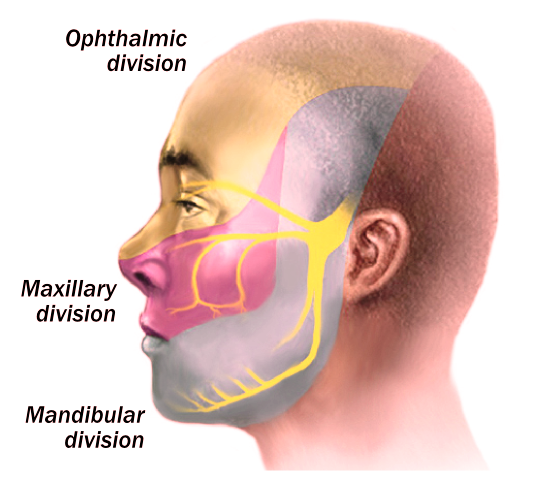Trigeminal Neuralgia: Common Causes, Symptoms & Treatment Options. Would You Like To Speak With A Therapist? Call (24/7): 1300-003-777.
Trigeminal neuralgia is a chronic pain condition affecting the Trigeminal nerve which supplies the skin of the face and scalp. People who suffer from Trigeminal neuralgia will tell you of their daily struggle with sporadic, burst-like, electric shock pain that may last a few seconds up to minutes or in extreme cases hours. Trigeminal Neuralgia is common in women over the age of 60 years however it’s important to recognize that anyone can be affected by this devastating condition at any point of their lives. The most simple tasks may set off an attack including being kissed on the cheek, chewing, biting, sensation of cold wind on the face, brushing your teeth, applying make-up, shaving, talking, smiling or washing the face.
Anatomy Of The Face & Skull
Your brain has twelve pairs of nerves that travel through the skull to areas of the head and neck. These nerves are not to be confused with spinal nerves. Spinal nerves begin in the spinal cord and travel through particular levels of the spine. The Trigeminal nerve is one of these cranial nerves and is divided into three parts, the opthalamic, maxillary and mandibular portions. Trigeminal neuralgia most commonly affects the maxillary and mandibular portions of the nerve.
Facial Neuralgia Treatment
Considering the close relationship between the Trigeminal nerve to the brainstem and cervical spine it’s no wonder so many sufferers consult with Chiropractors to assess whether they’re suitable for treatment. My clinical experience suggests that majority of people receive the most benefit from a technique referred to as upper cervical spine specific or Atlas Orthogonal. This technique is extremely gentle and focuses on the joints of the upper neck which are closely related to the brainstem and have the greatest influence upon the nervous system. Patients often report a lessening in pain intensity, improved ability to perform day to day activities as well as reduced sensitivity.
Other treatments available for Trigeminal Neuralgia sufferers have focused upon medications and drugs which like all pharmacological agents have the potential to produce side effects. The most common medications used include anti-convulsants and anti-spasmodic agents.
- Anti-convulsants
- Most commonly prescribed include Tegretol, Carbatrol and Gabapentin
- Side effects of anti-convulsants range from dizziness, confusion, drowsiness and nausea
- Anti-spasmodics
- Most commonly prescribed include Gablofen and Lioresal
- Side effects are similar to that of anti-convulsants
In rare cases, surgical intervention may be warranted if it is deemed no other therapy is effective.
Chiropractor Trigeminal Neuralgia Research
- Spinal manipulation and cranial mobilisation may positively influence causes of trigeminal neuralgia and therfore offers a conservative, low cost approach option. Pederick, F. (2005). Cranial and other Chiropractic adjustments in the conservative treatment of chronic trigeminal neuralgia. A case report. Chiropractic Journal of Australia, 35(1); 9 – 15
- In cases where Trigeminal neuralgia symptoms are exacerbated by cervical spine or TMJ syndrome then particular forms of manual therapy may be worth consideration. Rodine, R., & Aker, P. (2010). Trigeminal neuralgia and Chiropractic care: A case report. The Journal of the Canadian Chiropractic Association, 54(3); 177 – 186

